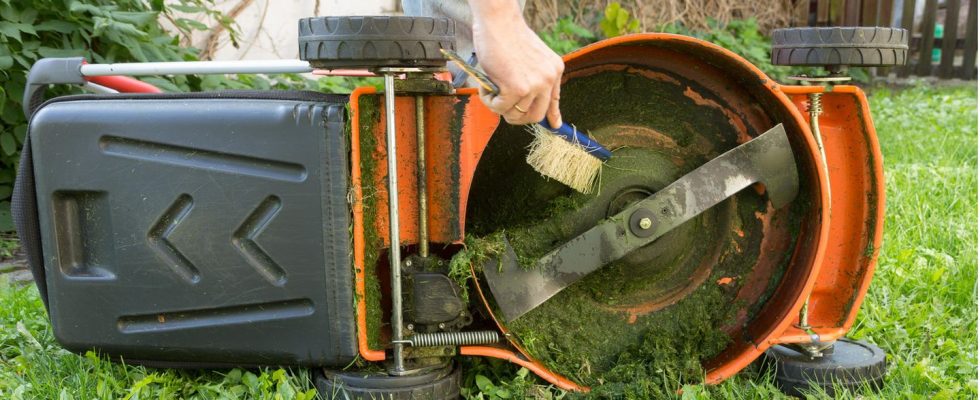series
Tips & Tools
Final spurt before the first frost: These gardening tasks are important in November
Gardeners with a cleaning obsession have a small advantage in November. Before the first frost comes, all garden tools should be thoroughly cleaned. >> Click here for the article.
© Aigars Reynolds/Getty Images
If you want to start the new gardening year in a good mood in spring, you should try again in November. What work needs to be done before the first frost and how to winterize spades, lawnmowers etc.
Even the warmest October since weather records began ended after 31 days. His calendar successor is having a particularly difficult time this year. It can only get colder, wetter and dark earlier. In many allotment garden associations the water is turned off in November. Mainly to prevent the pipes from being damaged in the frosty winter ground. But it is usually also the right time to finally say goodbye to the gardening year. Before the temporary farewell, a few construction sites should be worked on and garden tools sent into hibernation. You can find out what these are and what you need in the following article.
1. Use autumn leaves sensibly
The autumn wind is doing its best this year too, blowing the colorful leaves off the trees. They sail through the air and land on terraces, lawns, flower beds or in the gutters of garden arbors. You can find out how to protect the gutter from wet, annoying leaves and clogging here. Since fall leaves are organic material, you can throw them in the compost – but you don’t have to. The colorful leaves can help both plants and animals that spend the winter in the fresh air. To do this, the leaves must first be raked into a pile. This works best with one Leaf raking. And that’s the least you should do. In autumn and winter the stalks thirst for every ray of sunshine, no matter how thin. The leaves take away the already sparse light from the lawn. Ugly yellow-brown spots can result. For practical reasons alone, it is best to move the pile of leaves to a corner of the garden or property. If there isn’t enough space for this, you can’t go wrong if the leaves end up in the compost.
Shelter for insects and hedgehogs
Anyone who chooses the pile of leaves will gain sympathy points from small and micro creatures, but especially from hedgehogs. In November they comb through allotments with their short legs and look for a cozy place to rest in the winter. And it’s not just warm in the piles of leaves. The spiny four-legged friends also find insects and other small animals there to fill their stomachs with.
If you don’t just want to do something good for hedgehogs and your compost heap, you can also use the leaves as a warming “blanket” and mulching material for cold-sensitive perennials and beds. In the beds, the leaves perform three important tasks. On the one hand, they protect freshly planted strawberry plants, for example, from the cold. They also prevent the soil from retaining moisture for longer. In addition, microorganisms decompose the leaves and turn them into valuable fertilizer for free, which gets into the soil and helps the plants get going in spring.
Tip: With a Toom voucher save on your next purchase 15% (welcome discount)
2. Winterize the garden pond
Having your own garden pond is a nice thing. If you want to enjoy it for many years, you should dedicate some time to the biotope, especially in autumn. Especially if fish are kept in the water.
The five most important tips for making your garden pond winter-proof:
- Switch off the pond pump, filter system and other technology, drain them, clean them and store them in a frost-proof place
- With a Landing net Fishing leaves and rotten mud out of the pond, Leaf protection net to install
- Take fish out of the water (in shallow waters) and move them to winter quarters
- Cut back bank and water plants to a length of around 20 centimeters
- Secure the pond with fences and, if necessary, Ice preventer insert
3. Clean and maintain garden tools
Before spades, hoees and digging shovels are parked in the shed until spring, they should be thoroughly cleaned and prepared for their first use in the new gardening year. A wire brush or sandpaper is the best way to scrape the most stubborn chunks and small rust spots from the metal. Then wipe with a damp cloth (a little soap helps) and rub with a little oil.
Electrical devices such as hedge trimmers or lawn mowers should also be subjected to a thorough winter check after the last mowing. Very important: remove the battery and store it half charged in a dry place. Using a hand brush and a wooden spatula, you can then free the mower and the grass catcher from all mowing residues. A soft brush and lukewarm water then do the rest. This is even easier to do by hand if you dismantle the knives. A simple Allen key is usually sufficient for this. Also clean the knives thoroughly and rub them with a few drops of oil.
In order not to start the gardening season in spring with dull knives and scissors, the blades should be brought back into shape with a sharpening stone. When it comes to knives, this works best with a fine 1000 grit. For pruning shears, you can use a metal or Diamond file with a 300 or 600 grit. A splash of spray or penetrating oil also protects the moving parts from corrosion and extends the life of the scissors. Most scissors can be disassembled with small tools. This makes care easier.
You might also be interested in:
This article contains so-called affiliate links. Further information are available here.


